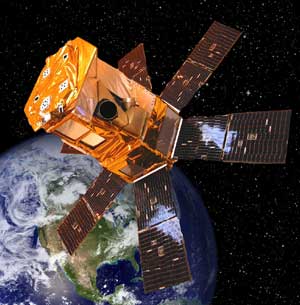
The Solar Radiation and Climate Experiment (SORCE) has seen a lot for a ten-year-old. Launched into Earth’s orbit on January 25, 2003, SORCE’s four LASP-built instruments have spent the past decade measuring solar energy in Earth’s atmosphere to help understand how the Sun affects climate change. SORCE has observed a gamut of solar events during this time, including intense surface eruptions and violent solar storms—and it’s not done quite yet.
Originally slated to last five years, the SORCE mission was extended in 2007, increasing its anticipated lifespan to 12 years. The satellite will reach its tenth launch anniversary this Friday, boasting a list of valuable accomplishments: It has witnessed the Sun transition from a normal solar cycle to a cycle of low solar activity, which may provide insight into how the Sun’s activity levels affect temperatures on Earth; observed the exceptionally intense Halloween solar storms of October and November, 2003; witnessed two rare transits of Venus, during which Venus passed between Earth and the Sun; and in 2008, saved $3 million in mission costs, allowing LASP to return money to NASA.
SORCE orbits Earth 15 times a day and measures the intensity of the Sun’s total energy as it hits Earth’s upper atmosphere, which is known as Total Solar Irradiance (TSI). It analyzes TSI in visible color that can be translated into quantities and elements of matter. Twice a day, CU-Boulder students help LASP mission operation professionals collect this data, which can be used to understand solar heating of Earth’s oceans, ice, land, and absorbing layers of the atmosphere.
The SORCE mission continues a seamless, long-term TSI data record that has been compiled by NASA and NOAA since 1978. Although SORCE’s battery is expected to last for at least one more year, LASP is preparing to pass SORCE’s TSI-recording responsibilities on to a new NOAA mission in 2013: The Total Solar Irradiance Calibration Transfer Experiment will carry a LASP-built Total Irradiance Monitor (TIM) similar to the TIM onboard SORCE, which measures TSI. The overlapping missions will prevent a gap in this critical 34-year NASA/NOAA climate data record as SORCE continues to age.
For more information on LASP’s contributions to the SORCE mission, please visit https://lasp.colorado.edu/missions-projects/quick-facts-sorce/.
(Video courtesy CU-Boulder)



